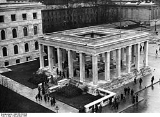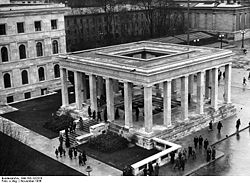
Ehrentempel
Encyclopedia

Munich
Munich The city's motto is "" . Before 2006, it was "Weltstadt mit Herz" . Its native name, , is derived from the Old High German Munichen, meaning "by the monks' place". The city's name derives from the monks of the Benedictine order who founded the city; hence the monk depicted on the city's coat...
, erected by the Nazis in 1935, housing the sacrophagi of the sixteen members of the party who had been killed in the failed Beer hall putsch
Beer Hall Putsch
The Beer Hall Putsch was a failed attempt at revolution that occurred between the evening of 8 November and the early afternoon of 9 November 1923, when Nazi Party leader Adolf Hitler, Generalquartiermeister Erich Ludendorff, and other heads of the Kampfbund unsuccessfully tried to seize power...
. On January 9, 1947 the main architectural features of the temples were destroyed by the US-Army as part of denazification
Denazification
Denazification was an Allied initiative to rid German and Austrian society, culture, press, economy, judiciary, and politics of any remnants of the National Socialist ideology. It was carried out specifically by removing those involved from positions of influence and by disbanding or rendering...
.
The first memorial
On November 8, 1933, Hitler addressed the party’s old guard at the BürgerbräukellerBürgerbräukeller
The Bürgerbräukeller was a large beer hall located in Munich, Germany. It was one of the large beer halls of the Bürgerliches Brauhaus company, and after Bürgerliches merged with Löwenbräu, the hall was transferred to that company. It was located on Rosenheimer Street in the neighborhood of...
(where the putsch had begun) and the next day unveiled a small memorial with a plaque underneath at the south side of the Feldherrnhalle
Feldherrnhalle
The Feldherrnhalle is a monumental loggia in Munich, Germany. It was built between 1841 and 1844 at the southern end of Munich's Ludwigstrasse next to the Palais Preysing and east of the Hofgarten. Previously the Gothic Schwabinger Tor occupied that place...
. Two policemen or the SS stood guard on either side of the memorial’s base and passers-by were required to give the Hitler salute.
The inaugration
In 1934 no commemorative march was made on the anniversary because of Hitler’s purge into the SA’s ranks in the Night of the Long KnivesNight of the Long Knives
The Night of the Long Knives , sometimes called "Operation Hummingbird " or in Germany the "Röhm-Putsch," was a purge that took place in Nazi Germany between June 30 and July 2, 1934, when the Nazi regime carried out a series of political murders...
. The next year on November 8 the putschists were exhumed from their graves and taken to the Feldherrnhalle where they were placed beneath sixteen large pylons bearing their names. The next day, after Hitler had solemnly walked from one to the next, they were taken down the monument’s steps and taken on carts, draped in flags to Paul Ludwig Troost’s new Ehrentempel monuments at the Konigplatz, through streets lined with spectators bustling between 400 columns with eternal flames atop. Flags were lowered as veterans slowly and orderly placed the heavy sarcophagi into place. In each of the structures eight of the martyrs were interred in a sarcophagus bearing their name.
The martyrs of the movement were in heavy black sarcophaguses in such a way as to be exposed to rain and sun from the open roof. When Gauleiter Adolf Wagner
Adolf Wagner
Adolf Wagner was a German soldier and high-ranking Nazi Party official born in Algrange, Alsace-Lorraine.He served in World War I as an officer in the German Army...
died from a stroke in 1944 he was interred metres away from the north temple in the adjacent grass mound in between the two temples.
Features
At the temples visitors were required to be silent, not wear hats and keep children from running over the centre of the temples. The Ehrentempel was made of limestone except for its roof which was made of steel and concrete with etched glass mosaics. The pedestals of the temples, which are the only parts remaining, are seventy feet wide. The columns of the structures each extended twenty-three feet. The combined weight of the sacrophagi was over 2,900 pounds.Post-war
On July 5 1945 the American occupying army removed the bodies from the Ehrentempel and contacted their families. They were given the option of having their loved ones buried in Munich cemeteries in unmarked graves or their family plots or having them cremated, common practice in Germany for unclaimed bodies. The columns of the structures were recycled into brake shoes for municipal buses and new material for art galleries damaged in the war. The sarcophagi were melted down and given to the Munich tram service who used it for soldering material to repair rail and electrical lines damaged by the war.On January 9, 1947 the upper parts of the structures were blown up. The centre portion was subsequently partially filled in but often filled with rain water which created a natural memorial. When Germany was finally reunited plans were made for a biergarten, restaurant or café on the site of the Ehrentempel but these were derailed by the growth of rare biotope vegetation on the site. As a result of this the temples were spared complete destruction and the foundation bases of the monuments remain intersecting on the corner of Briennerstrasse and Arcisstrasse. In the intermittent period of the 1947 destruction and 1990 handover basements (hitherto unknown to the Americans) were uncovered beneath the structures. A small plaque added in 2007 explains their function.
Interments
- Felix AlfarthFelix AlfarthFelix Allfarth was one of the earliest Nazi 'martyrs', having been shot dead during a gun battle with the police during the 9 November 1923 Munich Beer Hall Putsch at the Feldherrnhalle....
- Andreas BauriedlAndreas BauriedlAndreas Bauriedl was an early member of the Nazi Party. He worked as a hatter. He was a participant in the unsuccessful Nazi Beer Hall Putsch in Munich, Bavaria, on 9 November 1923....
- Theodor CasellaTheodor CasellaTheodor Casella was a bank clerk who participated in the attempted Nazi overthrow of the Bavarian Government. Casella was one of the sixteen Nazis to have been killed in the Beer Hall Putsch. He along with others are considered the first "martyrs" in the Nazi Regime and his death would become...
- William EhrlichWilliam EhrlichWilhelm Ehrlich was a German bank clerk, who participated in the attempted Nazi overthrow of the Bavaria, Munich government, which came to be known as the Beer Hall Putsch. During the stand off between the Nazis and the police, sixteen Nazis were killed including Ehrlich...
- Martin FaustMartin FaustMartin Faust was a bank clerk who participated in Adolf Hitler's failed coup, the Beer Hall Putsch. In the stand off between the Nazis and the police, Faust was killed by police bullets. Hitler dedicated his book Mein Kampf to him and the other "matyred" Nazis who died then....
- Anton HechenbergerAnton HechenbergerAnton Hechenberger was a locksmith who participated in Adolf Hitler's failed Beer Hall Putsch. He was killed in the standoff between the Nazis and the police. Hechenberger along with the other dead Nazis would be used in the ceremonies that the Third Reich conducted...
- Oskar KörnerOskar KörnerOskar Körner was a businessman who participated in Adolf Hitler's failed Beer Hall Putsch, in which he was killed....
- Karl KuhnKarl KuhnKarl Kuhn was a headwaiter in a restaurant and early member of the Nazi Party who was killed in the failed Beer Hall Putsch. Hitler would later dedicate his book Mein Kampf to him and the other "martyred" Nazis who died during the failed coup attempt....
- Karl LaforceKarl LaforceKarl Laforce was an early member of the Nazi Party who was killed in Hitler's failed Beer Hall Putsch. An engineering student, he was the youngest to die in the putsch. Hitler would dedicate his book Mein Kampf to him and the other "martyred" Nazis who died there....
- Kurt NeubauerKurt NeubauerKurt Neubauer was an early member of the Nazi Party and one of the first Nazis who was killed in Hitler's failed Beer Hall Putsch. He worked as a valet. Adolf Hitler dedicated Mein Kampf to him and 15 others....
- Klaus von PapeKlaus von PapeKlaus von Pape was a businessman and an early member of the Nazi Party who had participated in Hitler's Beer Hall Putsch and was one of the sixteen Nazis to have been killed. Hitler dedicated Mein Kampf to him as a fallen martyr, along with the others who died during the putsch....
- Theodor von der PfordtenTheodor von der PfordtenTheodor von der Pfordten was a county court councillor, who served in World War I and was an early member of the Nazi Party who took part in Adolf Hitler's failed Beer Hall Putsch in 1923. He along with fifteen others died trying to overthrow the government of Bavaria...
- Johann RickmersJohann RickmersJohann "Hans" Rickmers was a retired cavalry captain, who served in World War I, and was an early member of the Nazi Party. He believed that Adolf Hitler was the only one to restore Germany's military to strength...
- Max Erwin von Scheubner-Richter
- Lorenz Ritter von StranskyLorenz Ritter von StranskyLorenz Ritter Von Stransky was an engineer and early member of the Nazi Party who reportedly was so transfixed by Adolf Hitler's speeches that he couldn't resist joining the party. On the night of the Beer Hall Putsch, Stransky was hit with a police bullet and died along with 15 others...
- Adolf WagnerAdolf WagnerAdolf Wagner was a German soldier and high-ranking Nazi Party official born in Algrange, Alsace-Lorraine.He served in World War I as an officer in the German Army...
(buried in the grass mound between steps in 1944). - Wilhelm WolfWilhelm WolfWilhelm Wolf was a businessman and early member of the Nazi Party, who participated in Hitler's failed Beer Hall Putsch and was killed in the courtyard along with fifteen others. Hitler dedicated his book Mein Kampf to them, symbolizing them as heroes and martyrs of the Nazi struggle....

